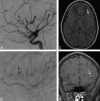Neurovascular manifestations in hereditary hemorrhagic telangiectasia: imaging features and genotype-phenotype correlations
- PMID: 25572952
- PMCID: PMC4433843
- DOI: 10.3174/ajnr.A4210
Neurovascular manifestations in hereditary hemorrhagic telangiectasia: imaging features and genotype-phenotype correlations
Abstract
Background and purpose: Hereditary hemorrhagic telangiectasia is an autosomal dominant disease that presents in 10%-20% of patients with various brain vascular malformations. We aimed to report the radiologic features (phenotype) and the genotype-phenotype correlations of brain vascular malformations in hereditary hemorrhagic telangiectasia.
Materials and methods: Demographic, clinical, genotypic, and imaging information of 75 patients with hereditary hemorrhagic telangiectasia with brain arteriovenous malformations enrolled in the Brain Vascular Malformation Consortium from 2010 to 2012 were reviewed.
Results: Nonshunting, small, superficially located conglomerates of enhancing vessels without enlarged feeding arteries or draining veins called "capillary vascular malformations" were the most commonly observed lesion (46 of 75 patients; 61%), followed by shunting "nidus-type" brain AVMs that were typically located superficially with a low Spetzler-Martin Grade and a small size (32 of 75 patients; 43%). Direct high-flow fistulous arteriovenous shunts were present in 9 patients (12%). Other types of vascular malformations (dural AVF and developmental venous anomalies) were present in 1 patient each. Multiplicity of vascular malformations was seen in 33 cases (44%). No statistically significant correlation was observed between hereditary hemorrhagic telangiectasia gene mutation and lesion type or lesion multiplicity.
Conclusions: Depending on their imaging features, brain vascular malformations in hereditary hemorrhagic telangiectasia can be subdivided into brain AVF, nidus-type AVM, and capillary vascular malformations, with the latter being the most common phenotype in hereditary hemorrhagic telangiectasia. No genotype-phenotype correlation was observed among patients with this condition.
© 2015 by American Journal of Neuroradiology.
Figures







References
-
- Bideau A, Plauchu H, Brunet G, et al. . Epidemiological investigation of Rendu-Osler disease in France: its geographical distribution and prevalence. Popul 1989;44:3–22 - PubMed
-
- Kjeldsen AD, Vase P, Green A. Hereditary haemorrhagic telangiectasia: a population-based study of prevalence and mortality in Danish patients. J Intern Med 1999;245:31–39 - PubMed
-
- Dakeishi M, Shioya T, Wada Y, et al. . Genetic epidemiology of hereditary hemorrhagic telangiectasia in a local community in the northern part of Japan. Hum Mutat 2002;19:140–48 - PubMed
